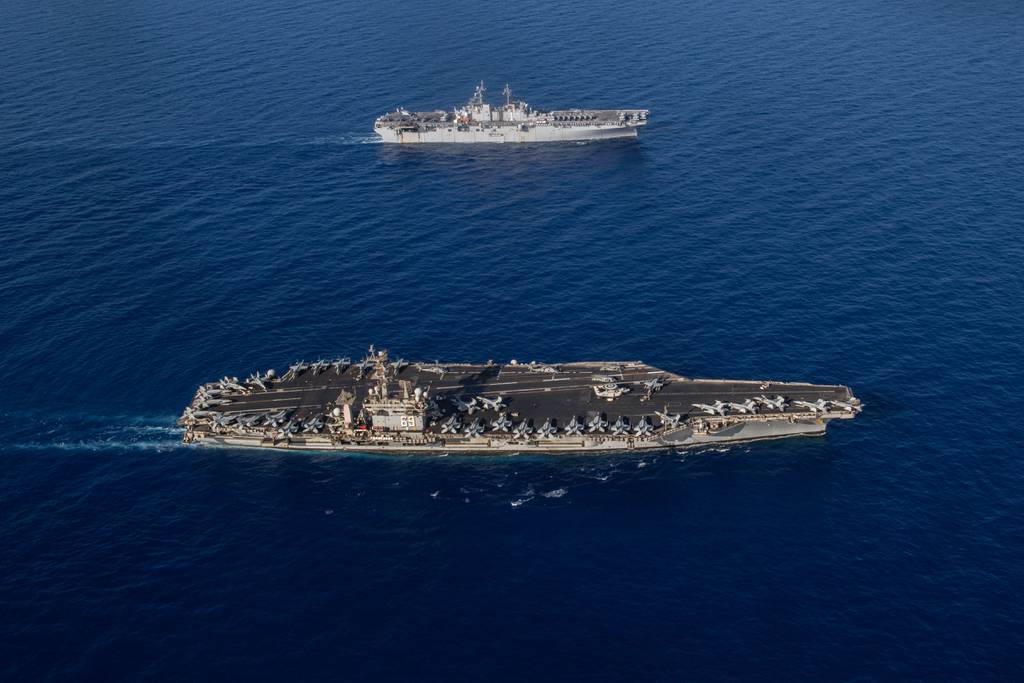Last month, Capt. Christopher “Chowdah†Hill, commanding officer of the aircraft carrier Dwight D. Eisenhower, invited journalists to inspect the flight deck of his carrier while it was underway in the Red Sea.
The journalists reported seeing nothing wrong on the flight deck, which was precisely the point of Hill’s invitation. Ike and its crew remained on station, with no hole in the deck.
Two weeks earlier, a spokesman for Yemen’s Houthi rebel movement announced that the rebels had struck the Eisenhower with a barrage of missiles to punish the United States for its support of Israel in its war against Hamas.
On X (formerly Twitter), Houthi supporters shared a video allegedly showing a large crater at the forward end of the Eisenhower’s flight deck. Other accounts posted a different image of a fiery blast aboard the ship.
The purported evidence of a strike spread quickly across Chinese and Russian social media platforms, thanks in part to the efforts of Russian sites with a reputation in the West for spreading disinformation.
The Houthis’ online conjuring of a successful attack on Ike that never happened complements their months-long campaign to disrupt commercial shipping in the Red Sea that has sunk commercial vessels and injured civilian mariners.
And while the U.S. military and allies regularly hit back with airstrikes against Houthi missile launchers and other assets in Yemen, the Pentagon is less prepared to defend against the online lies and disinformation that the Houthis are spreading.
In the instance of the false Ike attack, Capt. Hill took matters into his own hands, leveraging his 86,000 followers on X. The day after the false claims emerged, Hill began to post videos and still images showing normal operations aboard his ship, including a plane landing on the flight deck and trays of muffins and cinnamon buns fresh from the oven in the ship’s bakery.
Meanwhile, independent analysts exposed how the Houthis generated their false evidence of a missile strike on the Eisenhower.
An Israeli analyst demonstrated that the supposed photograph of a crater on the carrier’s flight deck consisted of a stock image of a hole superimposed on an overhead shot of the Eisenhower taken from satellite imagery dated almost a year before the alleged strike.
The fictional attack on Ike did not come as a surprise to anyone tracking Houthi disinformation efforts. In an ironic example from March, a Telegram channel and a pro-Houthi website shared an AI-generated image of a burning vessel they identified as the Pinocchio, an actual commercial ship the Houthis had targeted but missed.
The Houthis’ supporters had pulled their supposed evidence from a website that shared free stock images. However, no one from the Pentagon officially debunked this image as the Israeli analyst did for the fake photos of Ike.
In addition to these forgeries, pro-Houthi accounts have posted actual images of commercial vessels in flames, claiming the destruction resulted from Houthi attacks.
Yet in those cases, one image showed a burning ship on the Black Sea while another showed events that took place off the coast of Sri Lanka. Pro-Houthi posters even attempted to portray a blurry photo of a distant volcano as a successful strike on an Israeli ship.
This deluge of deceptively labeled images spread was also met with crickets from the Pentagon.
The U.S. military appears to grasp the need to counter disinformation spread by the Houthis and other regional adversaries. In February, the Joint Maritime Information Center, or JMIC, launched its efforts to provide accurate information to shipping companies about Houthi strikes, both real and imagined.
The JMIC operates under the umbrella of the Combined Maritime Forces – a naval partnership of 44 nations under the command of the top U.S. admiral in the region, who also serves as commander of U.S. 5th Fleet.
This is a start, but the Navy has yet to show that it can debunk false information as quickly as the Houthis post it online.
It is fortunate that an Israeli civilian had the skill and commitment necessary to expose the alleged crater aboard the Eisenhower as a work of photoshopping. He posted his conclusions on X four days after the Houthis publicized the supposed attack. Ideally, the Navy itself should be prepared to debunk such propaganda as soon as it appears.
Standing up this kind of capability should be a priority for the JMIC, which could include such efforts in its existing weekly updates.
It is important to act now before the Houthis’ disinformation apparatus becomes more sophisticated. Already, one of its supporters’ fake images of a burning ship garnered 850,000 views on X.
Moreover, the challenge is not limited to the Red Sea or the Middle East. Military forces in every command should have public affairs and open-source intelligence personnel working together to debunk false and exaggerated claims of enemy success on the battlefield.
Max Lesser is senior analyst on emerging threats at The Foundation for the Defense of Democracies, a non-profit, non-partisan think tank.








